The places to visit in Bhutan in February offer a calm, grounded travel experience. Snow brushes the mountain passes, while prayer flags flutter against icy skies. February is a time when Bhutan holds onto its rhythm, untouched by heavy crowds or noise. From riverside fortresses in Punakha to remote monasteries in Bumthang, every location feels more personal. Nature is present in the silent trails, frozen riverbanks, and fog-tipped trees. If you want clarity, solitude, and a deeper connection with the landscape, February stands out as the right time to explore Bhutan.
10 Places To Visit In Bhutan In February
The following places to visit in Bhutan in February are ideal if you’re looking to experience its culture, nature, and everyday life without the noise of peak season.
1. Paro Taktsang
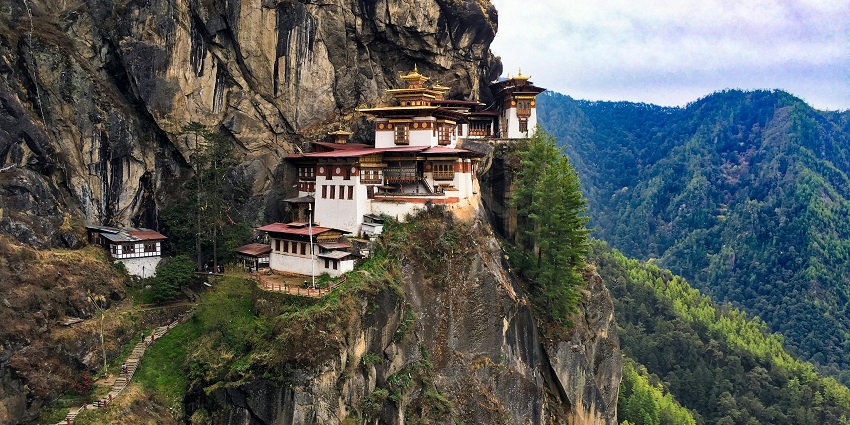
Perched on a granite cliff over 3,000 metres high, Paro Taktsang is Bhutan’s most iconic landmark and a spiritually profound destination, especially in February. Though the winter air bites, the trail remains open and walkable—best tackled with early sunlight. The two- to three-hour climb winds through pine forests, prayer flags, and quiet rest stops. Along the way, distant chants and bell chimes echo through the valley. At the monastery, relics and murals honour Guru Padmasambhava. After descending, teahouses offer warm suja and fire-cooked Bhutanese meals.
How To Reach: Drive 30 minutes from Paro town to the base, followed by a 2 to 3-hour trek.
Timings: 8 AM – 1 PM & 2 PM – 6 PM
Cost: ₹500 for Foreigners
Major Attractions: Rinpung Dzong, Kyichu Lhakhang, National Museum of Bhutan
2. Buddha Dordenma
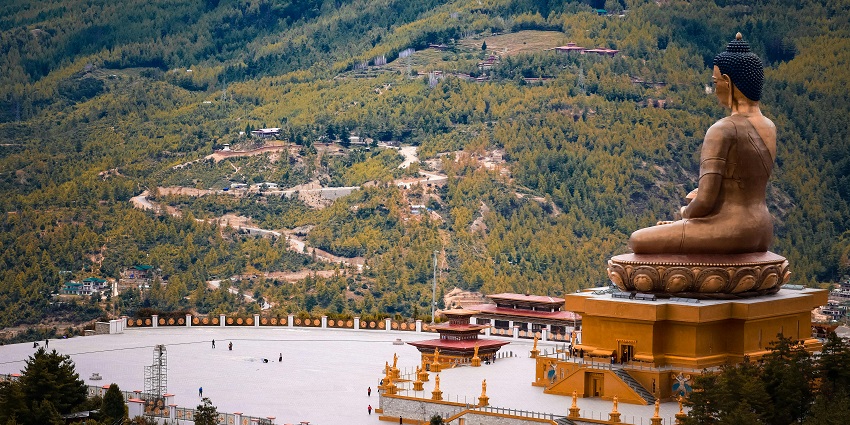
Photo: Soonam Wooeser / Pexels
Above Thimphu Valley, the Buddha Dordenma statue rises over 50 metres high, glowing against February’s clear blue skies. One of Bhutan’s most impressive sights this time of year, it offers more than sweeping views—the statue houses over 100,000 smaller bronze Buddhas within its golden frame. Surrounding it, Kuenselphodrang Nature Park invites winter walks and quiet reflection. February’s calm allows peaceful time inside the statue’s chambers, lined with gilded offerings and butter lamps. Though mornings are crisp, the midday sun warms viewing platforms and snow-dusted trails overlooking Thimphu’s serene, ridge-framed valley.
How To Reach: Located 20 minutes by car from central Thimphu
Timings: 9 AM – 5 PM
Major Attractions: Tashichho Dzong, Changangkha Lhakhang, Folk Heritage Museum, Centenary Farmers Market
3. Punakha Dzong
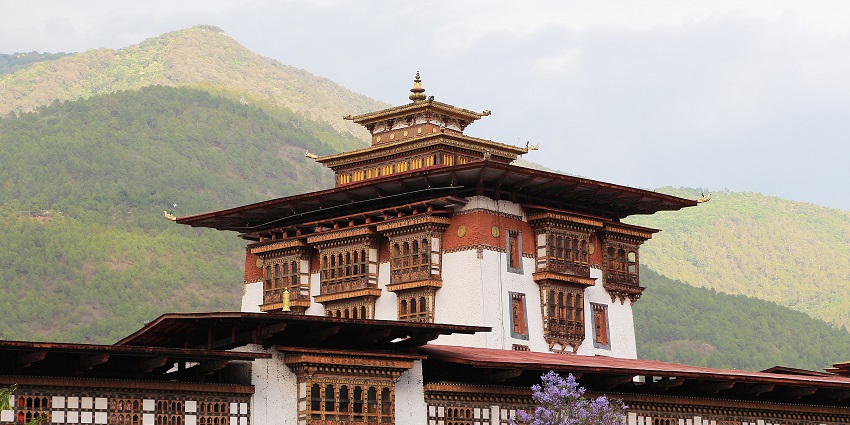
Photo: Bernard Gagnon / Wikimedia Commons
Set at the confluence of two rivers, Punakha Dzong is among the most architecturally splendid and seasonally vibrant places to visit in Bhutan in February. Early signs of spring begin to appear in the valley, with jacaranda buds emerging along riverside paths. Inside the dzong, richly carved wooden corridors lead to ancient thangkas, sacred relics, and lattice windows overlooking the Mo Chhu and Pho Chhu rivers. The central utse holds revered religious texts, guarded by monks at prayer. With Tshechu rehearsals underway, February offers a serene yet culturally rich experience in pleasant daytime weather.
How To Reach: 4-hour drive from Paro via Thimphu and Dochula Pass
Timings: 9 AM – 5 PM
Cost: ₹500 for Foreigners
Major Attractions In Punakha: Suspension Bridge, Chimi Lhakhang, Khamsum Yulley Namgyal Chorten
4. Gangtey Monastery
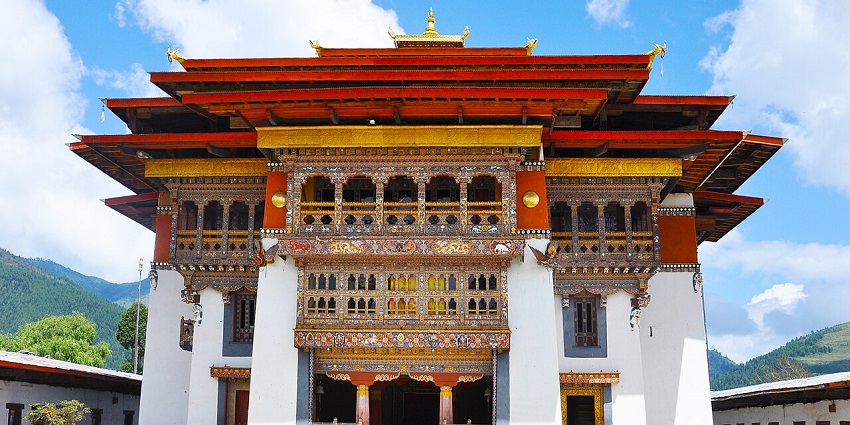
Photo: Prof Ranga Sai / Wikimedia Commons
Gangtey Monastery rests on a forested ridge overlooking the wide, bowl-shaped Phobjikha Valley—one of the most tranquil places to visit in Bhutan in February. Though colder than Punakha or Thimphu, the air is clearer, and the stillness of winter suits the valley’s quiet charm. Black-necked cranes gather in the marshes below, their presence lending a poignant beauty. The monastery, an old Nyingma school, has a modest exterior and richly painted inner sanctums. Perimeter trails pass yaks, stupas, and farmland, while nearby shops offer woollen scarves and handwoven winter goods.
How To Reach: 6-hour drive from Thimphu, via Wangdue
Timings: 8 AM – 5 PM
Cost: ₹250
Major Attractions In Phobjikha Valley: Black-necked Crane Centre, nature trails, traditional farmhouses
5. Lhakhang Karpo And Nagpo
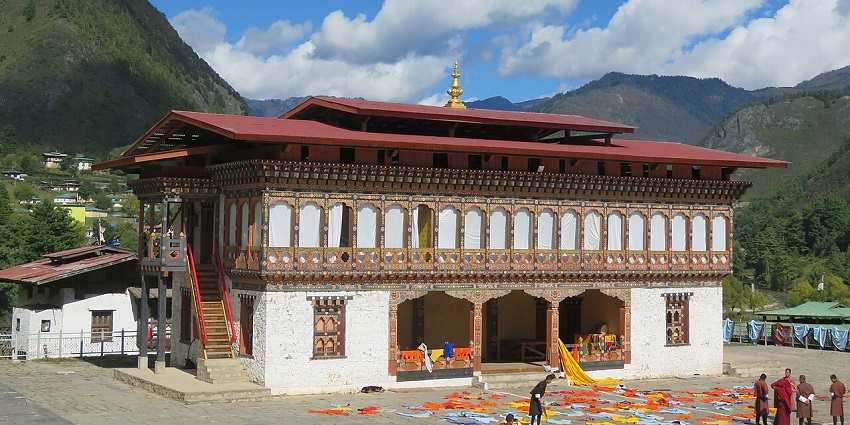
Photo: Vinayaraj / Wikimedia Commons
In the narrow folds of Haa Valley, the twin temples of Lhakhang Karpo and Lhakhang Nagpo are one of the most serene places to visit in Bhutan in February. With Chele La Pass accessible this month, the drive to Haa is scenic and snow-dusted, crossing high ridges and pine-covered slopes. Once in the valley, these two sacred temples, known as the White and Black temples, stand quietly in a sparse settlement, separated by a few hundred metres but linked by legend. Inside Lhakhang Karpo, soft light filters through ancient prayer flags and falls across altars layered with relics and butter lamps.
How To Reach: 3-hour drive from Paro over Chele La Pass
Timings: 8 AM – 5 PM
Major Attractions: Haa Chu River, Dobji Dzong, local hot stone bath experiences
6. Kurjey Lhakhang
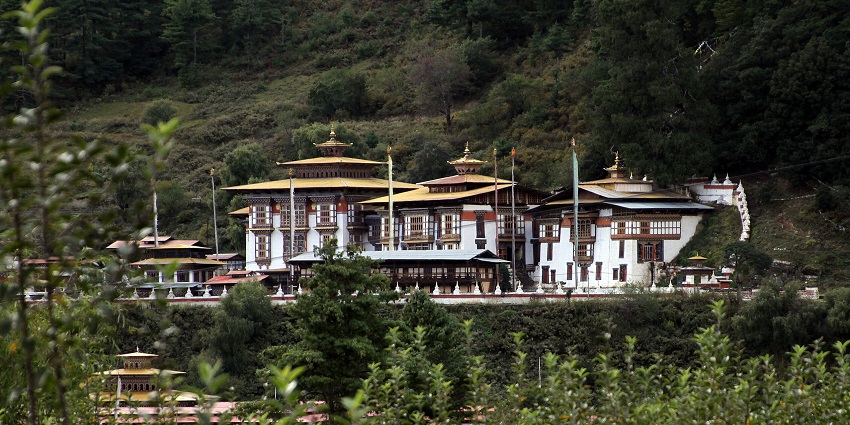
Photo: Gerd Eichmann / Wikimedia Commons
Kurjey Lhakhang is among the holiest sites in Bhutan. It is built around the meditation cave of Guru Padmasambhava. The temple complex has three main buildings, each constructed during a different century. You can still see the rock wall inside the oldest structure. It is where the Guru is believed to have left his body imprint. The walls are covered with murals that depict Buddhist teachings and episodes from Bhutanese history. Monks continue their daily prayers in the temple halls, and the grounds are peaceful, with very few travellers around. After visiting the main complex, it’s worth following the riverside trail towards nearby temples and mani walls.
How To Reach: 1-hour drive from Bathpalathang Airport or 10–12 hour road trip from Thimphu
Timings: 8 AM – 5 PM
Cost: ₹500 for Foreigners
Major Attractions In Bumthang: Jambay Lhakhang, Tamzhing Monastery, Mebar Tsho
7. Dochula Pass And 108 Chortens
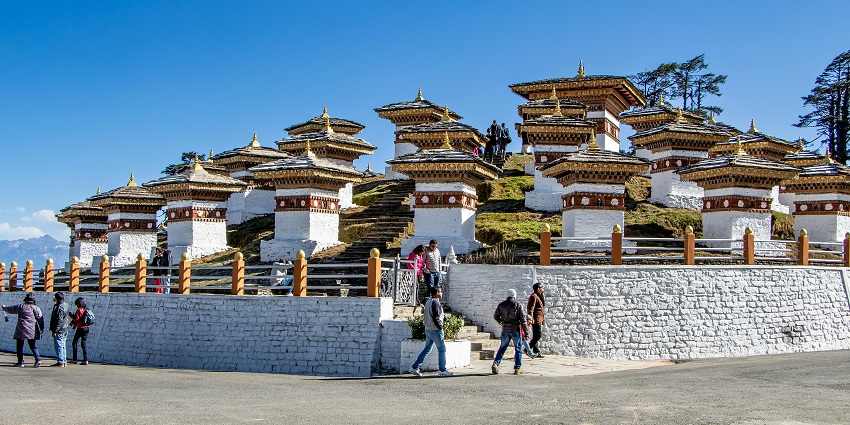
Dochula Pass connects Thimphu and Punakha, and at 3,100 metres, it offers some of the most uninterrupted views of Bhutan’s eastern Himalayas. February skies are usually clear, making it one of the best months to visit if you want to see the snow-covered peaks in the distance. The main attraction here is the cluster of 108 chortens built in memory of fallen soldiers, encircled neatly on a green mound that’s often dusted in frost this time of year. A short walk uphill brings you to Druk Wangyal Lhakhang, a monastery that combines traditional Bhutanese craftsmanship with murals that include modern elements, such as portraits of the Fourth King and symbols of national service.
How To Reach: 1-hour drive from Thimphu on the way to Punakha
Timings: 24*7
Major Attractions Around Dochula: Druk Wangyal Lhakhang, snow-capped peaks, hilltop cafés
8. Trongsa Dzong
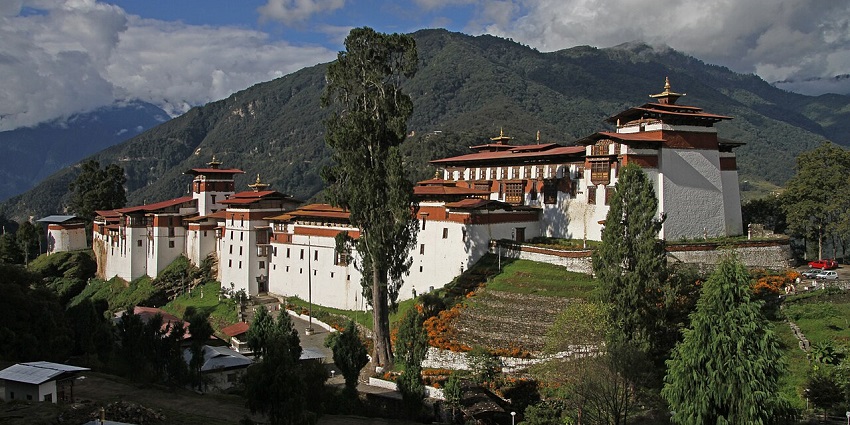
Photo: Gerd Eichmann / Wikimedia Commons
Trongsa Dzong, perched on a steep ridge above the Mangdeu River, is one of Bhutan’s most strategically vital fortresses. Once the seat of royal power, every Bhutanese king must serve here before ascending the throne. Visiting in February reveals its dramatic setting at its most striking. Inside, tiered courtyards, stone stairways, and wooden corridors connect prayer halls, offices, and living quarters. Its massive layout reflects its dual role as a fortress and administrative hub. Nearby, the Ta Dzong watchtower, now a museum, showcases royal artefacts, ceremonial items, and historic photographs.
How To Reach: 6-hour drive from Punakha or Bumthang
Timings: 9 AM – 5 PM
Cost: ₹500 for Foreigners
Major Attractions: Ta Dzong Museum, Mangdue River views, old royal palace pathways
9. Tala Hydropower Viewpoint
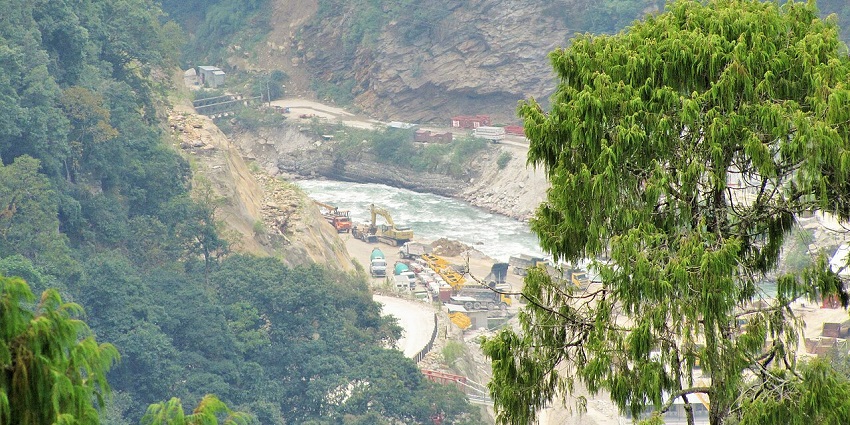
Photo: Chuck Moravec / Wikimedia Commons / Image For Representation Only
The Tala Hydropower Viewpoint in Chhukha district offers a quiet yet fascinating stop in Bhutan. Overlooking the country’s largest power station, the Tala Hydroelectric Project, it provides sweeping views of the Wang Chhu River and surrounding hills. The journey there winds through pine forests and rural villages, offering glimpses of everyday life. With few tourists, the atmosphere is peaceful and authentic. Visitors often stroll around the viewpoint, enjoy tea or snacks at roadside stalls, and explore nearby monasteries or hiking trails that lead into the forested slopes.
How To Reach: 2.5-hour drive from Thimphu
Major Attractions In Chhukha: Chhukha Dzong, Monasteries along Wang Chhu River, forest walks
10. Rinchengang Village
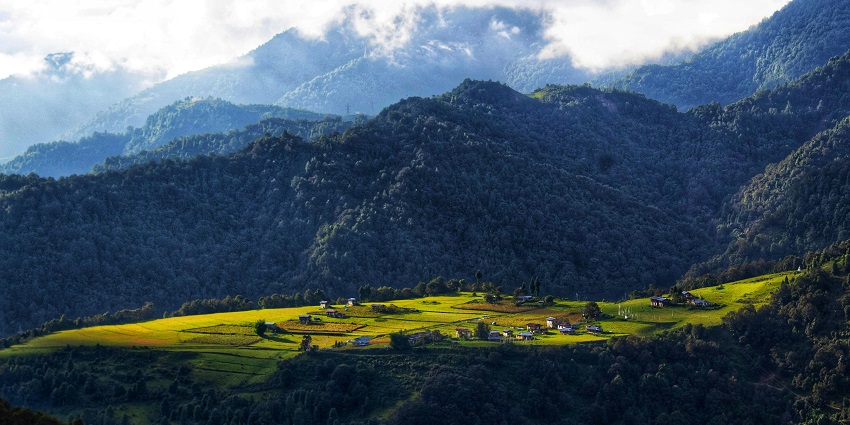
Photo: Ugyen Tshewang / Pexels / Image For Representation Only
Rinchengang Village, perched on a hillside opposite Wangdue Phodrang Dzong, is known for its traditional stone masonry and strong community spirit. Reached by a short uphill walk, it offers an authentic glimpse into rural Bhutanese life. The compact stone houses, built without cement, showcase a rare architectural style preserved for centuries. Visiting in February, you’ll feel a dry winter chill and see smoke curling from chimneys in the early mornings. Narrow village paths lead you past locals weaving, stacking firewood, and going about daily routines, making it a peaceful, off-the-beaten-path experience.
How To Reach: 1-hour drive from Punakha
Major Attractions: Wangdue Phodrang Dzong (visible from afar), temple paths, riverbank prayer wheels
These places to visit in Bhutan in February offer a unique experience unlike any other season. From cliffside temples in Paro to the crane-filled wetlands of Phobjikha, each destination showcases stunning winter scenery, rich history, and diverse wildlife. The roads stay open, the air is crisp, and the serenity is unmatched. Local rituals, monastery chants, and peaceful scenic walks await. Plan your unforgettable winter journey with TripXL today.
Cover Photo: Soonam Wooeser / Pexels


 WhatsApp
WhatsApp
 Twitter
Twitter









